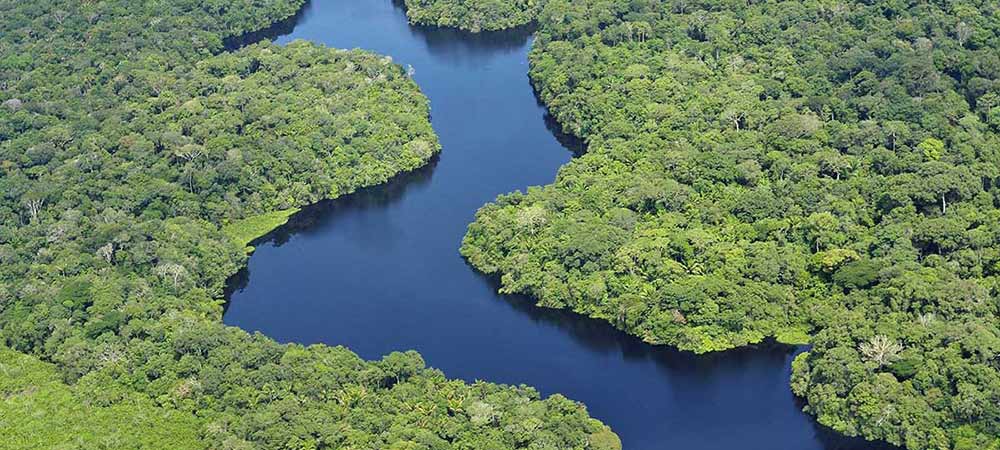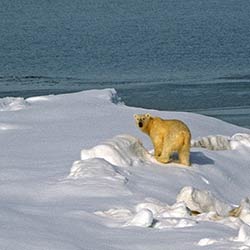
Dear EarthTalk: What can I do to help prevent deforestation in the Amazon even if I don’t live in the region? — Janine Greco, Nutley, NJ
The fact that our climate, our air and our water know no national borders means that the forests are our mutual responsibility. We all depend on their services and we all play a part in causing deforestation even if we live far away geographically. Also, deforestation is occurring everywhere on the planet, not just the in the Amazon rainforest, so doing your part locally could help retain tree cover and improve air quality in your region.
Most, if not all, deforestation is ultimately driven by our consumption, so avoiding products and companies responsible for deforestation is the logical first step. While it may seem obvious, asking about the source of the wood you are using on your next home repair project — and rejecting it if it comes from the tropical rainforest — will help efforts to prevent deforestation. Mahogany, ipê and other tropical hardwoods should be avoided unless they are certified by the Forest Stewardship Council, a non-profit which vets sustainably harvested timber operations around the world.
Another way to do your part to fight deforestation is to cut back on or eliminate meat from your diet. Cattle from the Amazon basin are most likely raised on ranches that used to be part of the rainforest. Likewise, expanding soybean farms in Brazil to feed cattle is a huge reason for Amazon deforestation. If you can’t give up meat entirely, at least eat less and get it from local producers practicing organic techniques. Meatless Monday, a project of the Center for a Livable Future (CLF) at the Johns Hopkins Bloomberg School of Public Health, provides many resources and ideas to try to get Americans to cut their meat consumption by at least 15 percent.
The expansion of palm oil plantations in tropical regions is the latest insult to tropical rainforests. Making your own homemade food and health and beauty products is one way to be sure you are avoiding palm oil, but you could also start by researching what you want online to find the best ready-made choices free of palm oil. Ethical Consumer’s Palm Oil Free Product List, which includes dozens of rainforest-friendly baby foods, cereal bars, chocolate bars, pet foods, shampoos and soaps, is a good place to start.
And who knew that resisting the urge to upgrade your perfectly good cell phone or computer could help prevent deforestation? Mining throughout tropical regions in Central Africa and beyond for metals and minerals that go into our electronics leads to wide swaths of rainforest destruction as well. Buying electronics made from recycled materials when possible and avoiding products with built-in “planned obsolescence” — your old phone will probably work well for a few more years — are more ways to be part of the solution.
And of course, there’s no better way to fight deforestation than by planting trees. The Arbor Day Foundation provides lots of tips for starting or joining a tree planting campaign in your neck of the woods.
CONTACTS: Forest Stewardship Council, us.fsc.org; Meatless Monday, www.meatlessmonday.com; Ethical Consumer’s Palm Oil Free List, www.ethicalconsumer.org/shoppingethically/palmoilfreelist.aspx; Arbor Day Foundation, www.arborday.org. Photo above: Even if you live thousands of miles away, you can help prevent deforestation in the tropical rainforests of the Amazon and elsewhere by making smart consumer choices. Credit: Neil Palmer (CIAT)

With summer approaching, many of us are eagerly anticipating the first night we can gather with loved ones under the stars around our backyard fire pits. But neighbors might have not-so-warm feelings about wood smoke entering their yards and homes. According to the U.S. Environmental Protection Agency (EPA), wood smoke is a complex mixture of gases and microscopic particles, and when these microscopic particles get into your eyes and respiratory system, they can cause health problems such as burning eyes, runny nose and bronchitis.
As part of its “Burn Wise” program, EPA warns that people who have heart or lung disease, such as congestive heart failure, angina, chronic obstructive pulmonary disease, emphysema or asthma, should especially limit their exposures to wood smoke. If you’re concerned about smoke emitting from a neighbor’s fire pit, speak to your neighbor about the matter. If the smoke remains an issue, contact your local health or fire department to determine further action.
If you’re in the market to buy a fire pit and would like to avoid having smoke drift into your neighbor’s yard or home, some models are specially designed to reduce smoke output. The American-made Backyard Firefly fire pit, for example, utilizes a vertical design that causes the smoke to be combusted in the fire and the remainder to rise vertically, reducing air pollution by over 50 percent from conventional campfires. There are also a multitude of beautifully designed natural gas fire pits currently available. Natural gas fire pits won’t produce smoke, will instantly light and won’t have to be cleaned like wood-burning fire pits that accumulate ash and soot residue.
If you already own a wood-burning backyard fire pit, you can replace conventional wood with certain varieties of Duraflame Logs. Duraflame Stax logs are shaped like split wood and burn with the same charred appearance and crackling sounds of a wood fire, but with half the hazardous air pollutants of an equivalent wood fire. Duraflame Campfire Roasting Logs create hot coals safe for roasting marshmallows, hot dogs or cooking other campfire foods and produce 60 percent less particulate emissions than an equivalent wood fire. No trees are cut down to produce these logs and they are made of 100 percent renewable resources.
For those who own a wood-burning fire pit and would like to continue using conventional chopped wood, the EPA Burn Wise program advises to use only properly dried wood, because wet wood can create excessive smoke. To allow wood to properly dry, stack wood away from buildings on rails in a single row with the split side down. Cracked ends on the wood typically mean it’s dry enough to burn, or you can purchase a moisture meter to test the moisture level in the wood. “Moisture meters that allow you to test the moisture level in wood are available in all sizes and can cost as little as $20,” the EPA states. “Properly dried wood should have a reading of 20 percent or less. Dry wood creates a hotter fire. Hotter fires save wood — ultimately saving you time and money.”
CONTACTS: EPA Burn Wise, epa.gov/burnwise/; Backyard Firefly, www.backyardfirefly.com; Duraflame Roasting Logs, www.duraflame.com/products/roasting-logs.

The Energy East Pipeline is a $12 billion project proposed by TransCanada Corp. that will combine existing, converted natural gas pipelines with new pipeline construction to carry oil some 2,800 miles across Canada from Alberta’s tar sands fields to export terminals in Quebec and New Brunswick. Unlike TransCanada’s Keystone XL pipeline proposal, which aims to transport oil from Alberta to Nebraska, Energy East would not directly cross into the U.S. But environmentalists on both sides of the border are concerned since Energy East would transport 1.1 million barrels of tar sands oil a day — 25 percent more than Keystone XL — and will be the longest oil pipeline on the continent.
Just as Keystone XL has been shrouded in controversy and debate in the U.S., Energy East faces fierce opposition in Canada, where groups like Environmental Defence and the Council of Canadians believe the pipeline threatens both sensitive ecosystems and populated areas with the risk of a spill. According to the report Liquid Pipeline — “Extreme Energy’s Threat to the Great Lakes and the St. Lawrence River,” by Maude Barlow of the Council of Canadians — Energy East would cross the northern end of the Great Lakes, including the St. Lawrence River Basin watershed, threatening many water systems along the way.
“In its preliminary project description filed with the National Energy Board in March 2014, TransCanada outlined details about its plans to build a port in Cacouna, Quebec, just north of Rivière-de-Loup on the St. Lawrence River,” the report states. “Local residents are very concerned that any accidents involving either the pipeline or marine shipments along this route would put the already endangered beluga whale population at greater risk.”
For its part, TransCanada says that it “understands the important role all aquifers, rivers and lakes play in maintaining sensitive and vital ecosystems across Canada,” but asserts that “pipelines remain the safest, most efficient and most environmentally friendly mode of transporting energy across the continent.” Before the Energy East pipeline goes into service, TransCanada plans to clean and thoroughly inspect the converted section of the pipeline. The company has also promised to avoid crossings of important water bodies to minimize disturbances of sensitive aquatic ecosystems. Highly-trained technical staff in TransCanada’s control center would monitor the pipeline 24/7.
While construction and maintenance of the Energy East pipeline would create some 14,000 jobs during its first seven years while providing upwards of $7.6 billion in tax revenue to pay for schools, roads and other public services across Canada, many Canadians remain concerned that a spill could threaten or destroy their livelihoods.
Regardless of these concerns, TransCanada is currently working to get final regulatory approval from Canada’s National Energy Board (NEB) to start work on Energy East and hopes to have construction completed by the end of 2018. Environmentalists are still holding out hope that NEB will reject Energy East on environmental and/or socio-economic grounds, and continues to drum up support across Canada and beyond for shelving the beleaguered pipeline.
CONTACTS: Energy East Pipeline, www.energyeastpipeline.com; Environmental Defence, www.environmentaldefence.ca; Council of Canadians, www.canadians.org.

While we may not yet have reached the “point of no return” — when no amount of cutbacks on greenhouse gas emissions will save us from potentially catastrophic global warming — climate scientists warn we may be getting awfully close. Since the dawn of the Industrial Revolution a century ago, the average global temperature has risen some 1.6 degrees Fahrenheit. Most climatologists agree that, while the warming to date is already causing environmental problems, another 0.4 degree Fahrenheit rise in temperature, representing a global average atmospheric concentration of carbon dioxide (CO2) of 450 parts per million (ppm), could set in motion unprecedented changes in global climate and a significant increase in the severity of natural disasters — and as such could represent the dreaded point of no return.
Currently, the atmospheric concentration of CO2 (the leading greenhouse gas) is approximately 398.55 parts per million (ppm). According to the National Oceanic and Atmospheric Administration (NOAA), the federal scientific agency tasked with monitoring the health of our oceans and atmosphere, the current average annual rate of increase of 1.92 ppm means we could reach the point of no return by 2042.
Environmental leaders point out that this doesn’t give us much time to turn the tide. Greenpeace, a leading environmental advocacy group, says we have until around 2020 to significantly cut back on greenhouse gas output around the world — to the tune of a 5 percent annual reduction in emissions overall — if we are to avoid so-called “runaway” climate change. “The world is fast approaching a ‘point of no return’ beyond which extremely dangerous climate change impacts can become unavoidable,” reports the group. “Within this time period, we will have to radically change our approach to energy production and consumption.”
In a recent lecture at Georgetown University, World Bank president Jim Yong Kim reported that whether we are able to cut emissions enough to prevent catastrophe likely depends on the policies of the world’s largest economies and the widespread adoption of so-called carbon pricing systems (such as emissions trading plans and carbon taxes). International negotiators meeting in Paris next December are already working to hammer out an agreement mandating that governments adopt these types of systems to facilitate emissions reductions. “A price on carbon is the single most important thing we have to get out of a Paris agreement,” Kim stated. “It will unleash market forces.”
While carbon pricing will be key to mitigating global warming, Greenpeace adds that stemming the tide of deforestation in the world’s tropical rainforests and beyond and adapting our food systems to changing climatic conditions and increasingly limited resources will also be crucial to the health of the planet.
“Without additional mitigation, and even with adaptation, warming by the end of the 21st century will lead to high to very high risk of severe, widespread and irreversible impacts globally,” reports the Intergovernmental Panel on Climate Change (IPCC), an international group of leading climate experts convened by the United Nations to review and assess the most recent scientific, technical and socio-economic information on global warming. Indeed, there’s no time like the present to start changing our ways.
CONTACTS: NOAA, www.noaa.gov; World Bank, www.worldbank.org; Greenpeace, www.greenpeace.org; IPCC, www.ipcc.ch.












